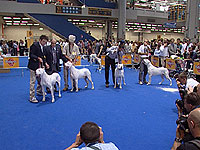Appearance
Essentially a white Mastiff, the Dogo Argentino is a powerful dog with a massive skull and strong jaws. Similar in size to a Rottweiler, they stand around 61-69 cm (24-27 inches) in height and weigh between 36 to 45 kilograms. The ears are surgically amputated to heighten the aggressive look of the dog. The coat is short, thick and smooth and is normally pure white in colour. The eyes are either dark brown or dark hazel and the nose should be black. The long tail reaches to the hock.
Temperament
The Dogo Argentino was bred with the intention of creating a hunting dog which was aggressive and fearless in nature and also a tough guardian.
While some texts describe the Dogo Argentino as trustworthy with people and exceptionally loyal, the breed is banned in Australia and Great Britain due to concerns about its temperament. At Burke’s Backyard we fully support this ban.
In countries where the breed is permitted, they require a dominant master. The Dogo Argentino requires early socialisation with other animals and early obedience training is vital. Dogos can be aggressive with other dogs but will not usually provoke the confrontation. The Dogo is not a dog that can be expected to get along well at a dog park with a lot of strange dogs. It is generally not recommended to try to keep a male Dogo in the same household with another male of a large breed. This is asking for trouble. Dogos also often exhibit frustration or displacement aggression as well as food/bone guarding.
History
Also known as the Argentinian Mastiff, the Dogo Argentino is one of the few breeds developed in South America. In the 1920’s an Argentinian breeder wishing to produce a hunting dog with great stamina to hunt puma and jaguar created the breed using the old fighting dog of Cordoba, Spain and a mix of Great Dane, bulldog and boxer. Dogos were trained to hunt big game in packs. Breeders claim that the light coloured coat is desired for the function of deflecting, rather than absorbing heat, but since it is pure white skin cancer problems would be significant.
Health and lifespan
Like any large breed, Dogos are susceptible to Canine Hip Dysplasia (CHD) and should have the hips x-rayed to check for this condition. Congenital eye disorders such as Progressive Retinal Atrophy, Cataracts and Glaucoma, occur occasionally. As in any predominantly white animal, many Dogos are afflicted with partial or complete congenital deafness. An individual may be deaf in both ears (bilateral deafness) or in only one ear (unilateral deafness). Dogos can be BAER (Brainstem Auditory Evoked Response) tested by a veterinarian at an early age to determine if they are normal or unilaterally or bilaterally deaf.
Dogos are white and can get sunburned if they are left out in the sun all day. They are most likely to burn on the head where the hair is very short. For this reason, Dogos need shade when left outdoors for more than an hour or so. Alternatively, they do not handle extreme cold weather conditions well either and will need to be brought inside when the temperature drops.
Average lifespan is 10 to 12 years.
Feeding
An adult Dogo Argentino would cost around $15 per week to feed.
Breeding
The Dogo Argentino has an average litter size of 6 to 9 puppies.
Cost
Not available in Australia, currently classified as a prohibited import.
Space and exercise
This breed requires plenty of exercise and is best suited to homes with at least an average sized yard. They may be kept inside for part of the time if desired.
Ideal Owner
The Dogo Argentino is a highly intelligent, powerful dog which needs a firm and consistent but loving hand. They are good with other pets if they are raised with them from puppyhood. The Dogo is not a breed for first time dog owners and is best left to the care of experienced dog handlers.
Grooming
Breeders say the white coat is easy to care for and has no doggy odour. Special attention is needed for the fast growing nails of the Dogo which will need frequent clipping. The breed sheds an average amount of hair.
Uses
Originally bred to hunt in packs, the breed instantly appealed to people who organise and enjoy dog fights, an activity still popular in many parts of South America and elsewhere (but illegal in Australia). It has also reportedly been used as a sled dog and guide dog for the blind. Today the Dogo Argentino is used primarily as a companion dog or a guard dog.
Popularity
Not available in Australia.
Trainability
An intelligent and powerful breed with potentially lethal power, this white mastiff needs early obedience training and early socialisation with other animals and humans.



